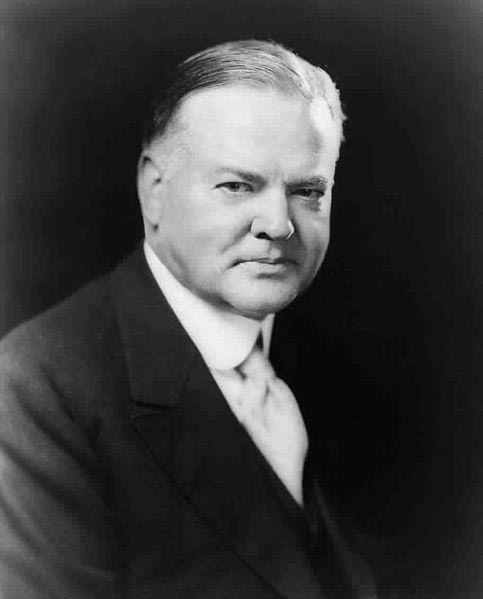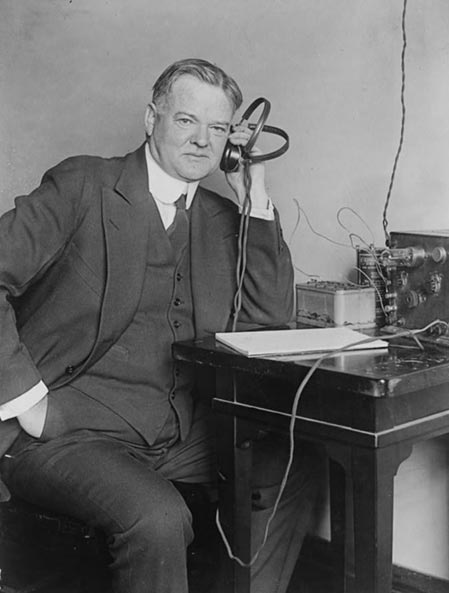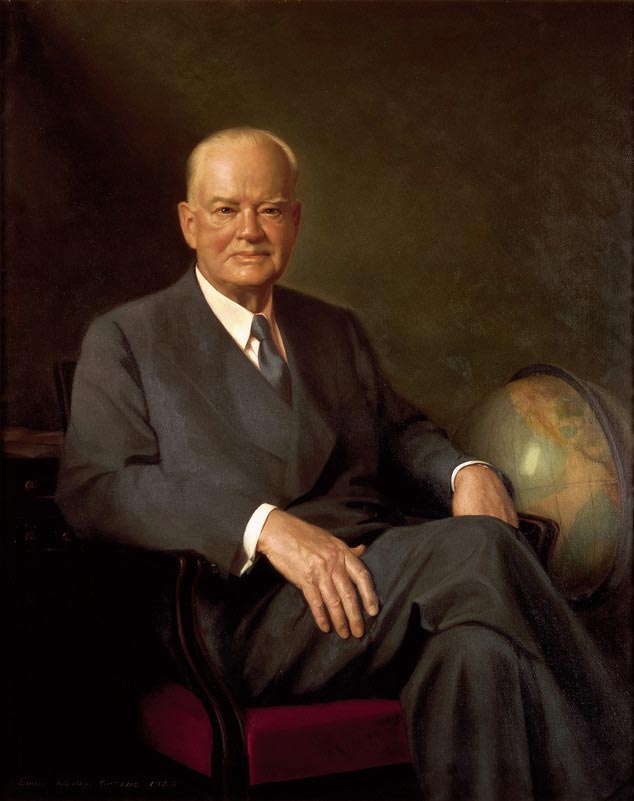| Herbert Hoover | |
|---|---|
 |
|
| 31st United States President « Previous Next » |
|
| In office | Mar. 4, 1929 – Mar. 4, 1933 |
| V. President | Charles Curtis |
| Political Party | Republican |
| Personal Info | |
| Born | Aug. 10, 1874 |
| Died | Oct. 20, 1964 (at age 90) |
| Religion | Quaker |
| School | George Fox University Stanford University |
| Profession | Mining engineer Civil engineer Businessperson Humanitarian |
| Signature | |
| Wife | Lou Henry |
| Children | Herbert Hoover, Jr. Allan Hoover |
| U.S. Presidents 26-35 | |
| 26. Theodore Roosevelt (1901-1909) | |
| 27. William H. Taft (1909-1913) | |
| 28. Woodrow Wilson (1913-1921) | |
| 29. Warren G. Harding (1921-1923) | |
| 30. Calvin Coolidge (1923-1929) | |
| 31. Herbert Hoover (1929-1933) | |
| 32. Franklin D. Roosevelt (1933-1945) | |
| 33. Harry S. Truman (1945-1953) | |
| 34. Dwight D. Eisenhower (1953-1961) | |
| 35. John F. Kennedy (1961-1963) | |
| List of All the Presidents |
Herbert Clark Hoover was the 31st president of the United States of America. It was during his term (March 4, 1929 – March 3, 1933) that the stock market crashed and led the country into the infamous Great Depression.
Early Life and Childhood
Hoover was born in West Branch, Iowa on August 10, 1874. He was the first and only Iowan President in the history of the United States. His parents, both Quakers, are Jesse and Hulda Hoover. Jesse Hoover, who was of German-Swiss descent, was a blacksmith, and farm implement dealer. His mother, born in Norwich, Ontario Canada, was believed to have come from Scotch-Irish and English bloodlines.
Hoover was six when his father died from a heart attack. Three years later, his mother also passed away due to pneumonia. Initially, a fellow Quaker, Laurie Tatum, was named his guardian and took care of him until he later lived with one of his grandmothers in Kingsley, Iowa. His paternal uncle, Allen Hoover, who lived in West branch, took care of young Herbert for eighteen months.
Three years after his parents died, he left Iowa to live with his maternal uncle and aunt, John and Laura Minthorn in Oregon. Hernert attended the Friends Pacific Academy over the next two years. He later worked as an office assistant for the Oregon Land Company. Oregon Land Company is a real estate company located in Salem and owned by his uncle. He was not able to attend high school but learned bookkeeping, math and typing by attending night school.
As an orphan, this led the young Hoover become self-reliant, industrious and independent. He maintained the values imparted by his religious mother. He grew up with great concern for less fortunate people. His passion for helping the poor, the abandoned and the oppressed, helped mold his character, evident throughout his life. This passion led him to be known as the most humanitarian President in the History of the United States. He remained simple in all his ways and embraced the humble demeanour Quakers are known for. This is evident in his speech, dressing, and socializing.
In 1891, Hoover entered Stanford University. This is where he met his soon to be wife, Lou Henry Hoover. While he was at Stanford, he was the manager for the football and baseball teams. In 1895, both Hoover and his girlfriend, Lou Henry, graduated with a degree in Geology.
Occupation
 After graduating from Stanford University, Hoover became a Mining Engineer. In 1897, he flew to Australia to serve as a Geologist and Mining Engineer for the London-based mining company, Bewick, Moreing, & Co. He was 23 years old when he was appointed as a mine manager. He worked at the gold mines in Big Bell, Cue, Leonora, Menzies and Coolgardie.
After graduating from Stanford University, Hoover became a Mining Engineer. In 1897, he flew to Australia to serve as a Geologist and Mining Engineer for the London-based mining company, Bewick, Moreing, & Co. He was 23 years old when he was appointed as a mine manager. He worked at the gold mines in Big Bell, Cue, Leonora, Menzies and Coolgardie.
It was during this time that he married Lou Henry. They had two sons, Herbert, Jr. and Allan Henry. They were transferred to China where Hoover became the company’s head engineer. When the Boxer Rebellion broke out in Tianjin on 1900, Hoover helped the US Marines battle the enemy as he guided them using his familiarity with the territory.
By 1901, Bewick, Moreing & Co. bestowed their trust on him as they made him a partner assuming responsibility for the Australia operations. He became an independent mining consultant in 1908. He has several publications related to mining under his name, including his’ (and his wife’s) English translation of the mining classic, De re Metallica.
Philanthropies
During World War I, Hoover assisted in organizing the homecoming of more than one hundred thousand Americans trapped in Europe. He headed hundreds of volunteers as they distributed relief goods, clothing and cash. When Germany invaded Belgium, food became scarce leaving many Belgians starving.
Hoover made every effort to ensure that food was sent to Belgium through the formation of the Commission for Relief in Belgium. While managing this commission, they were able to feed the entire country during the invasion. He became an international hero as he helped feed a lot of war victims persuading German authorities to allow them to ship relief goods to areas where there was a scarcity of supply.
By April 1917, the United States of America opted to enter the war. Then President Woodrow Wilson tasked Hoover to head the US Food Administration. Grounded in his belief that “food will win the war”, Hoover started encouraging people to avoid eating certain foods that they needed for their food distributions. Labelled as Hooverizing, this program reduced consumption of food needed for the war ration.
 When the war concluded, Hoover arranged food shipments for many starving European people located in Central Europe. They also sent relief for many nations regardless of their participation in the war; whether ally or foe, he made sure that wherever there are people starving, no matter what their politics were, they would be fed.
When the war concluded, Hoover arranged food shipments for many starving European people located in Central Europe. They also sent relief for many nations regardless of their participation in the war; whether ally or foe, he made sure that wherever there are people starving, no matter what their politics were, they would be fed.
This led him to be known as among the “Ten Most Important Living Americans” by the New York Times.
When he returned home in 1919, he was made aware that the Democratic Party was eyeing him to become the successor to President Wilson. Franklin D Roosevelt were among those who preferred that he run for presidency under the Democratic flag. His background prevented Hoover from becoming a Democrat.
He felt at that time that there is no way he can run for a party that did not have share his principles. Before the war, he had been a registered Republican; there was no way that a war could change that.
Secretary of Commerce
Hoover helped Warren G. Harding’s presidential race when he publicly endorsed him. After Harding was elected as president, he returned the favour by offering him to choose between becoming the Secretary of the Interior Government or the Secretary of Commerce. The Department of Commerce at that time was fairly new, as it had been operating for only eight years. During that time, the Secretary of Commerce was considered a minor Cabinet post with limited tasks that were not clearly defined.
Hoover envisioned Commerce as the country’s next source of growth. He took the post and made tremendous efforts in redefining the department. By the time he ended his service as the Secretary of Commerce, he was able to elevate the status of the department, making it one of the major departments responsible for the country’s unparalleled economic success.
The Presidency
 In 1928, Hoover was nominated as the Flag bearer of the Republican Party in the Presidential Election. He ran for the presidency with Senator Charles Curtis as his running mate. They positioned themselves as pro-business. Hoover was proven to be in better shape compared to his opponent Alfred E. Smith.
In 1928, Hoover was nominated as the Flag bearer of the Republican Party in the Presidential Election. He ran for the presidency with Senator Charles Curtis as his running mate. They positioned themselves as pro-business. Hoover was proven to be in better shape compared to his opponent Alfred E. Smith.
Hoover’s campaign would focus on promising farmers improved conditions, the reformation of the immigration law, and maintaining a strong foreign policy at the time. Hoover won the presidency, managing to crack the “Solid South” by winning votes in Southern Democratic states such as Virginia, Texas, North Carolina, Tennessee and Florida.
A year after he was elected, the stock market crashed. It was considered as the worst downfall in the history of stock trading. Hoover took all possible actions to deal with the worsening economic predicament. He urged private sectors and business leaders to participate by cutting off wages or to lay off workers.
The crisis was made even worst when the Great Depression surfaced in 1932. Despite all the efforts, the economy failed to counter Hoover’s initiatives. As time went by, the economic catastrophe led the United States of America to suffer the kind of poverty and hunger it had never experienced before. People began blaming Hoover’s policy and governance for the crisis.
As the US economy deflated, calls for government assistance increased. More people were asking the government to dole out money to assist them in their daily lives. Hoover declined all requests to pay individuals as he claimed that in doing so, people would lose the incentive to work. To cover up for this, he created policies that aim to lift the nation out of the economic distress. The Mexican Repatriation Program and Smooth-Hawley Tariff Acts were two of the most important policies he created. However, since the Great Depression had spread around the globe, all efforts to salvage what was left of the US economy failed.
In an effort to save Americans from becoming homeless, Hoover approved the Federal Home Loan Bank Act to start new home construction and reduce property foreclosures. Even with the passing of the Bill, people felt that it was “too little too late”.
Before leaving the office of the President, he made strenuous attempts to save the economy. He passed the Emergency Relief and Construction Act and created the Reconstruction Finance Corporation. Although it made some impact, the effect was not as significant as he had desired.
Hoover left the White House as president in March 1933. He brought with him disappointments and resentment over the fact that the American people did not acknowledge the efforts he made in an attempt to provide them with a better economy and governance amidst the crisis that made the entire world suffer.
Hoover, together with his family went to New York and settled in Waldorf-Astoria Hotel. After a brief stay, they later returned to live at their home in Palo Alto, California. As a private citizen, he enjoyed driving around visiting mining camps or small towns. Until the time of his death, he spent most of his days heading up the mountains or fishing.
Hoover died on October 20, 1964 at the age of 90. His death was declared after he suffered massive internal bleeding. At the time of his death, he was able to vindicate himself and essentially improve his public image. His remains were buried at the Herbert Hoover President Library and Museum in West Branch, Iowa. He was honoured with a state funeral.